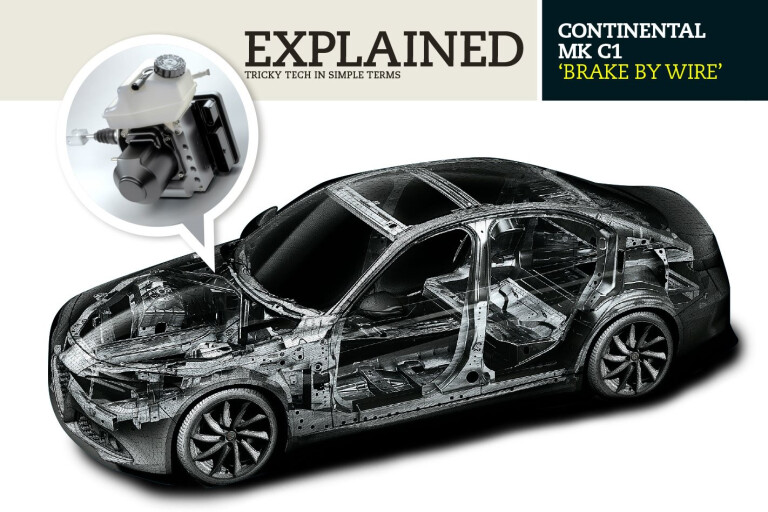
What is it?
An evolution of traditional vehicle braking systems that has remained fundamentally unchanged for decades.
Multiple system components are consolidated into a single unit for weight-saving, miniaturisation and faster brake response times.

Alfa Romeo is the first manufacturer to adopt the system in its Giulia mid-sized sedan, dubbed Integrated Brake System (IBS). Bosch is also developing a similar system it calls iBooster.
- Explained: GKN Tungsten-carbide coated brakes
- Explained: V2X Vehicle-to-everything communication
- Explained: Lift flexible wishbone suspension
How does it work?
A traditional system requires a master cylinder, vacuum servo and pump for boosting brake force, and ESC controller, but the Continental solution replaces the vacuum booster’s role with an integrated hydraulic pump and reduces system complexity to just one component.
Like a traditional master cylinder system, the brake pedal is still directly connected to the MK C1 unit for fail-safe redundancy. Instead of the pedal pressure directly modulating brake force, the unit uses a travel sensor, which sends a signal to the pump to alter braking performance electronically under changing conditions.

If the system fails, mechanical pressure applied to the unit from the driver’s foot still allows the brakes to work, albeit without power assistance or electronic modulation.
Why does it matter?
With fewer separate components, the system saves four kilograms over traditional approaches and is more compact allowing better vehicle packaging, but the advantages extend into performance benefits, says Alfa.
With a powerful brushless motor controlling brake force, a 100 bar per second pressure gradient is far faster than vacuum assisted systems, while response times are as little as 10ms, which reduces stopping distances.

The braking system can now be integrated into vehicle driving modes and when a sportier setting is selected the brakes can be mapped to feel more responsive, while comfort modes allow a less aggressive braking action.
Finally, the faster acting system is better suited for integration into emerging automated systems. By removing mechanical functions and separate components, a vehicle equipped with AEB can apply brakes faster in an emergency system when milliseconds count.
Regen for the next-gen
So-called ‘brake by wire’ systems are also allowing more efficient regenerative braking as electrification becomes more widespread in the automotive landscape.
zJust as the more sophisticated electronics allow more controlled braking performance, the system enables more controlled generation of electricity for charging vehicle batteries. The net result is EVs and hybrids that go further on a single charge.



COMMENTS